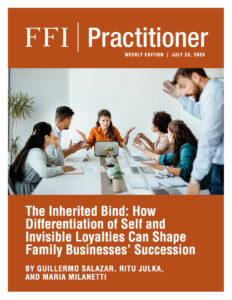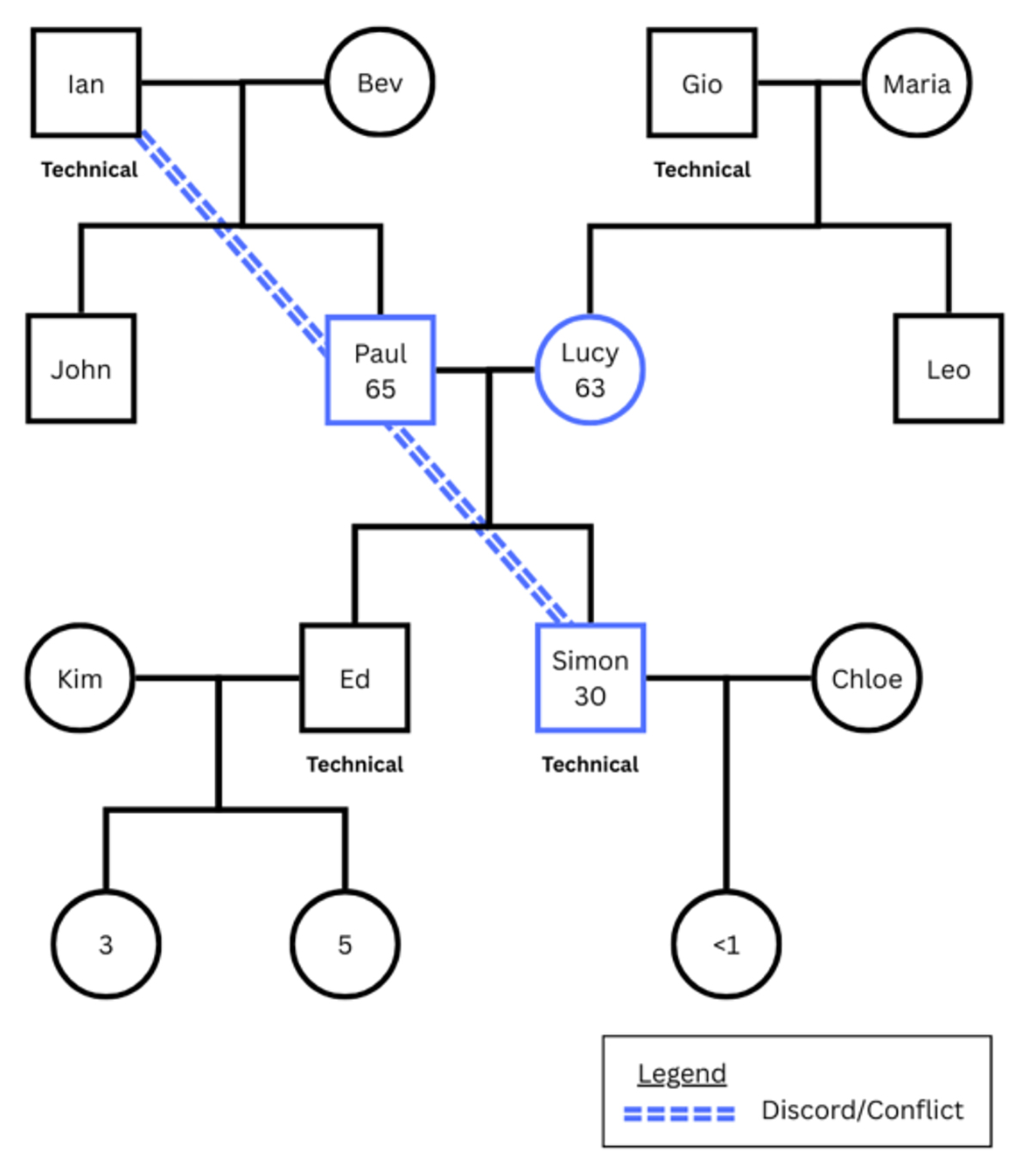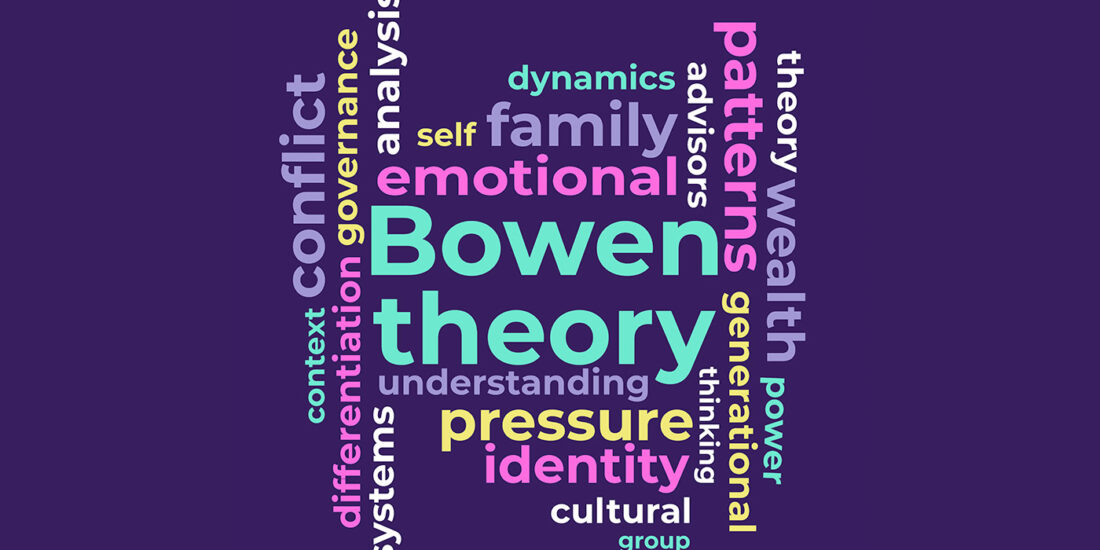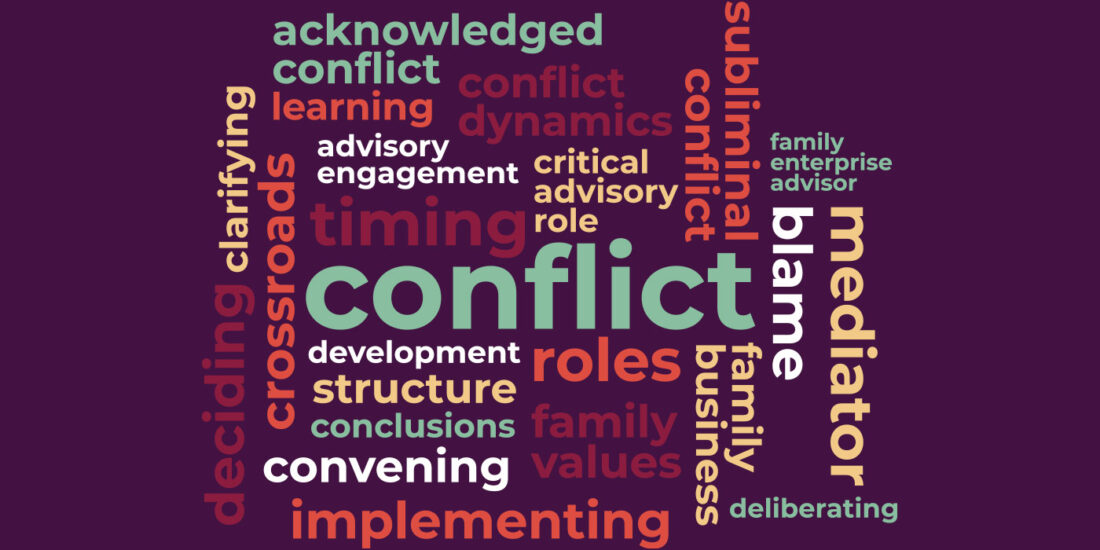
View this edition in our enhanced digital edition format with supporting visual insight and information.
Thank you to Guillermo Salazar, Ritu Julka, and Maria Milanetti from the Systems Thinking Virtual Study Group for this week’s edition. Their article uses a case study to discuss the concepts of “differentiation of self” and “invisible loyalties,” how both phenomena can play out in client families, and how advisors can identify them and intervene in conflict.
Case Study: Part 1
Every morning, Paul walks into the office thirty minutes before anyone else. He pours himself a black coffee and sits at the head of the long conference table, staring at the framed photo of the company’s first building. The silence used to feel like victory. Now, it feels like weight.
Outside his door, the business hums with life. His legacy. His pride. Yet something nags at him—a question he can’t quite name. His son, Simon, should be taking the reins by now. But he isn’t. Not really.
At 30, Simon shows up, yes—but with the air of someone visiting rather than belonging. He avoids the big decisions, drifts between roles, and carries a quiet distance that Paul doesn’t know how to bridge. Paul, once so sure of his instincts, now finds himself second-guessing everything.
“I think I’ve been a great father,” he admits one afternoon to an advisor he has called for help. “But maybe… a terrible boss.”
So begins a consulting engagement: not with a plan for succession, but with a reflection. The advisor invited both Paul and Simon to step into a process of open dialogue and—perhaps—transformation. No fixed outcome. Just the hope that clarity might emerge from courage.
At the Crossroads: Belonging and Becoming
Beneath their conversations lies a deeper current: What binds a father to his son in a family business? What loyalties go unspoken, inherited like invisible contracts? At what cost do we confuse love with obligation?
In family enterprises, the tension between belonging and becoming is not a passing phase—it’s a permanent undercurrent. Belonging speaks to our desire for acceptance and continuity, to be seen as part of the family fabric; becoming, by contrast, reflects the drive for individuation and growth, the pursuit of one’s own path—even when that means challenging the very system that provides identity and security.
Emotional, ethical, and cultural ties are deeply intertwined with decision-making, identity, and leadership. Two vital psychological dynamics—differentiation of self and invisible loyalties—often determine whether individuals thrive within the business or remain unconsciously bound by legacy roles.
The path to healthy succession and sustainable governance in family businesses involves much more than financial acumen. It requires a psychological and relational maturity that allows members to simultaneously honor their roots and step into their future. The ideas we present here merge theoretical insights and practical experiences to explore how families can recognize and transform these hidden dynamics into sources of strength, not stagnation.
Understanding the Differentiation of Self
Psychiatrist Murray Bowen described the differentiation of self as a person’s capacity to stay emotionally connected to their family while maintaining a clear, grounded sense of self.1 In the context of a family business, this means being able to articulate one’s own values, vision, and leadership style—even when those diverge from the family narrative.
Differentiated individuals don’t disappear in the face of tension. They remain present in difficult conversations without becoming reactive or defensive. They can disagree without disconnecting, and lead without dominating. In a family firm, this emotional clarity becomes a wellspring of innovation, empathy, and resilience.
The opposite is equally common and more destructive. When differentiation is low, two patterns often emerge: emotional cut-off, where autonomy is pursued through distance or silence, and emotional fusion, where loyalty becomes submission, and individuality gets swallowed by family expectations. Both extremes undermine the health of the family and the future of the business.
The Power of Invisible Loyalties
Ivan Boszormenyi-Nagy introduced the idea of invisible loyalties—unconscious emotional debts and entanglements passed down through generations.2 These loyalties are rarely discussed, but they govern behavior with quiet authority, as can be seen in these examples:
- A son who stays in the business out of duty, not desire.
- A daughter who turns down a promotion to avoid overshadowing a sibling.
- A successor who mimics a founder’s rigid style, believing that to lead differently would be a betrayal.
- A family that resists expansion, afraid it might dilute the “soul” of the company passed down by grandparents.
These are not business decisions. They are acts of silent devotion, written in a family’s invisible ledger—a metaphorical system of emotional accounting that tracks sacrifice, obligation, and unspoken rules.
While such loyalty may stem from love and gratitude, it often leads to role confusion, self-sabotage, and organizational paralysis. When left unexamined, these dynamics shape not just individual choices but the very culture of the enterprise.
But when families begin to name these loyalties—to understand their historical roots and bring them into the light—they create room for transformation. What once constrained can begin to guide. What was once inherited can become consciously chosen.
Case Study: Part 2

The turning point didn’t come in a dramatic confrontation, but in quiet revelations.
So that he could see where he could add value, Simon agreed, as part of the ongoing engagement, to participate in an assessment designed to surface not just competencies but also motivations and inner alignment.
The results were unmistakable. Simon lit up around anything technical. Engineering, systems, problem-solving—these were the domains where he came alive. And yet, here he was, cast in the role of sales leader, the same position Paul had once mastered. Simon was wearing a suit that never quite fit.
When asked how he felt in the role, Simon hesitated, then said quietly, “It doesn’t feel like me.”
That was the first honest thread. The coaching process began.
Over the next year, the advisor worked on two fronts. With Simon, the work focused on clarity: exploring what he truly wanted, whether within or beyond the business. With Paul, the path was more delicate: a gradual unfolding of what it meant to love a son enough to let him go.
At first, the idea of leaving the business felt almost blasphemous to Simon. The guilt was visceral. “If I walk away,” he confessed, “I’m not just quitting a job—I’m abandoning him.”
But somewhere along the journey, something shifted. The coaching didn’t offer quick answers. It offered space. Reflection. Permission.
And slowly, Simon began to realize he could leave. He could choose his own path without dismantling the relationship. That thought alone—so simple, yet so foreign—was liberating.
For the first time, Simon saw his future not as a continuation of someone else’s story, but as the beginning of his own.
Consequences of Undifferentiated Leadership
Sometimes succession triggers loyalty, rivalry, and self-denial as generations struggle between legacy, identity, and leadership transition. When invisible loyalties overpower self-definition, common symptoms can emerge:
- Role confusion, as individuals feel split between family expectations and personal goals.
- Emotional fusion or cut-off, leading to either unhealthy dependence or detachment.
- Strategic paralysis, as conflict is avoided and no one takes clear leadership.
Worse yet, if next-generation leaders internalize the belief that not to lead means to betray, they may decline leadership altogether. Others may step into power without conviction, playing a role rather than embodying it. The cost of this is not just business risk—it’s personal, relational, and intergenerational.
To address this particularly delicate phase of transition, an advisor could try practical interventions including these suggestions:
- Naming the Loyalties: What are the unspoken rules that family members are following? What past are they afraid of betraying?
- Supporting Differentiation: Encouraging personal expression and authentic leadership, not roles inherited by default.
- Creating Psychological Safety: Normalizing disagreement as a sign of engagement and strength, not disloyalty.
- Honoring Legacy While Enabling Change: Using symbolic acts, storytelling, and collaborative reflection to weave continuity with evolution.
Case Study: Part 3
In the end, Simon didn’t take over the family business. He walked away—not in rebellion, but in clarity.
Through the coaching process, he came to see that for years, he had been playing a role designed for him, not by him. He wore the title, followed the script, and smiled in meetings. But nothing in him resonated with the part.
One day, he resigned. He sold his house, sold his car, bought a truck, and started a plumbing business.
It wasn’t a dramatic gesture—it was liberation. He partnered with a friend, built the business from the ground up, and continued his coaching through that crucial first year, with his family’s support and the right to choose. In doing so, he reclaimed not just his career, but his voice.
Conclusion
As we learn from this case and others, the solution is not to reject loyalty, but to make it conscious and intentional. True loyalty involves showing up authentically, voicing dissent when necessary, and co-creating the future.
When advisors help families to make visible the invisible and to make conscious the unconscious, things start to move forward.
This reframing turns loyalty from a constraint into a bridge—a way of carrying forward what matters most while shedding what no longer serves.
Differentiation of self and invisible loyalties are two sides of the same coin: the push for personal identity and the pull of family belonging. The key is not in choosing between self and system, but in learning to be fully oneself within the system. When families learn to balance these forces, they not only strengthen their enterprises but build legacies of wisdom, resilience, and integrity.
Bibliography
Boszormenyi-Nagy, Ivan, and Geraldine Spark. Invisible Loyalties: Reciprocity in Intergenerational Family Therapy. Harper & Row, 1973. Reprint, Brunner/Mazel, 1984.
Bowen, Murray. Family Therapy in Clinical Practice. Jason Aronson, 1978.
Family Firm Institute. Family Enterprise: Understanding Families in Business and Families of Wealth. John Wiley & Sons, 2014.
Jaffe, Dennis. Borrowed from Your Grandchildren: The Evolution of 100-Year Family Enterprises. Wiley, 2020.
References
1 Bowen, Family Therapy, 424.
2 Boszormenyi-Nagy and Spark, Invisible Loyalties, 39.
About the Contributors

Guillermo Salazar, FFI Fellow, is founder of Exaudi Family Business Consulting. He is an expert on family governance, strategic succession planning, generational transition, and conflict resolution. A founding member of the FFI Iberoamérica VSG and chair of the 2019 Global Conference Program Committee, he received the 2015 FFI International Award and previously served on both the FFI Board of Directors and the GEN Faculty. He can be reached at guillermo.salazar@exaudionline.com.

Ritu Julka, CFBA/CFWA, is the founder and managing partner of CoSculpt Consultancy and an organization development specialist. Her expertise spans leadership development, culture transformation, organization effectiveness, HR advisory, family governance, and next-generation transition. She brings the depth of systems coaching to organization development and family business consulting. She can be reached at ritujulka@cosculpt.com.

Maria Milanetti, FFI Fellow, is partner, family enterprise and independent business, at MarchFifteen Consulting Inc., a firm specializing in executive and leadership assessment, individual and team development, and executive coaching. Maria also advises clients in business transition and strategic planning. She can be reached at mmilanetti@marchfifteen.ca.

View this edition in our enhanced digital edition format with supporting visual insight and information.





